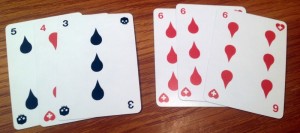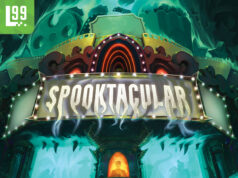Note: This preview uses pre-release components and rules. What you see here may be different from the final, published game.
 Rummy was a popular game at my grandparents house whenever I visited. My grandpa and I would try our hardest to beat my grandma when we played. Despite our best efforts, she would destroy us most of the time. When I saw that game Draw Blood on Kickstarter, I was interested since it was a new take on the classic game. Although it did bring up some bad memories…
Rummy was a popular game at my grandparents house whenever I visited. My grandpa and I would try our hardest to beat my grandma when we played. Despite our best efforts, she would destroy us most of the time. When I saw that game Draw Blood on Kickstarter, I was interested since it was a new take on the classic game. Although it did bring up some bad memories…
Draw Blood is a rummy style card game where players try to get rid of the cards in their hand as quickly as possible with the help of monster cards. Draw Blood is a 2-3 player card game that plays well under five minutes per round. Is Draw Blood an improvement on Rummy or should you just stick to the original? Read on reader.
Game Overview:
In Draw Blood, players are attempting to get rid of all the cards in their hand before the other players at the table. The quickest way to do this is to lay down melds of cards, either sets of 2-6 of a kind or three numbers in order. The problem is you can’t play any of these melds by yourself. Players need to play one of the three types of monsters in the game to gain that ability, as well as more actions if they play more monsters. Players have to manage playing melds and killing other player’s monsters to make sure they are the first to get rid of all the cards in their hand. Cards played in melds are positive points for the player, while cards in their hands at the end of a round count as negative. Rounds will continue until a player has reached the agreed upon victory point total and they win the game.
How to Play:

The game is set up with each player having three locations on the table where game play occurs. First is a draw/discard area where players will draft and discard a card each turn. Each player has their own monster row, in which they can have one of each of the three types of monsters. Finally, each player also has a meld area in front of them. Each player starts with ten cards and play begins.
There are three types of cards in the game. Number cards are used by players in melds to score points and to kill or revive a monster. The monster cards come in three varieties Vampires, Werewolves and Water monsters and are only played in the monsters row in front of the players. The kill cards allow for a player to cover another players monster, stopping it from giving that player extra move actions.
Each player draws a card at the start of their turn and, depending on the number of monsters they have in their row, determines the number of moves they can complete on their turn. If a player has no monsters in their row they do have options on their turn. Players can take their one move action to play a monster in their row, discard a card from their hand into the discard pile, or kill an opponent’s monster. If a player has at least one monster in their monster row, they can now play melds with their one move. For each card played in a meld, a player will earn points at the end of the game. You may also play off other players melds in your own area, only gaining points for the cards in your area.
Players can also use sets of three to revive a monster or kill a monster, however, players don’t gain any points for that at the end of the round. When players get two monsters on the board, they can take two moves and three when they get a third monster in the row. Play will continue until one player has played all of the cards in their hand. All players gain 5 points for every numbered card played in a meld. Players who still have cards in their hands count negative 5 for each number card, and each monster or kill card in a players hand counts for negative 10 and 20 points respectively. The game will end when a predetermined point total is reached or players have played a certain number of rounds with most points being the winner.

Game Experience:
I wasn’t expecting a lot when I first read through the rules for Draw Blood. I thought it would be a game that mimics rummy a lot and wouldn’t have much improvement over the base game. After many games, I’m glad I was wrong.
I do like how simple this game is to learn. Rummy is a game that doesn’t have many difficult choices to make. Draw Blood adds a lot more strategic decisions without adding confusion on how to play it. Even if players are not familiar with rummy rules, the game is easily learned in just 10 minutes. The game is extremely compact with just 54 cards and can be taken anywhere. It also doesn’t take up a ton of space while you are playing, making it a good travel game.

The main selling point for me is the added layer of interaction and decision making that players have to make on each turn. Players need to get monsters out on the table as quickly as possible, giving them the ability to play melds. The problem with doing this right off the bat is you have a huge target on your back and players will start doing everything they can to kill off your monster collection. Players must keep a close eye on what each player is doing to try to hinder them from getting rid of their cards. Being able to play off other peoples melds is a great way to get rid of random cards that you might gain in your hand.
One very interesting rule is if a player plays a pair down as a meld and another player makes it three of a kind they can then use that to kill or revive a monster depending on the color of the card. Not only stealing points, but doing something else makes me never want to play down two cards. I love how the melds of three of a kind have another use. It makes it a difficult decision to make because you don’t earn points by killing or reviving monsters. You have to balance every move you make in this game to get rid of your hand as efficiently as possible. I found myself thinking a lot about each move I made in this game.
Only issue I had with the game is sometimes the luck of cards are not on your side. You can end up with a collection of cards that you can do very little with. This can be frustrating if your opponent goes out quickly sticking you with a lot of negative points. This does not happen often, but stinks when it does. The good thing is that rounds take a short amount of time to complete. So if you end up with a bad hand, you quickly move on to the next one. Despite that one problem I found it an enjoyable experience each time I played.
Final Thoughts:
Draw Blood mechanics work together to build a very well designed card game. The monster cards, player interaction and multiple uses of melds allow for a game that isn’t intimidating to play but has enough decision making to keep players interested. If you are looking for a new card game to travel with or play against the family, give Draw Blood your support.
If you are interested in the game, it is currently in funding on Kickstarter and scheduled for delivery in December 2013. A pledge of $10 will get you a copy of the game and all the stretch goals. You have until Thursday, October 31th to become a backer so head over now.
As always, we don’t post ratings for preview copies as the components and rules may change from the final game. Check back with us after the game is produced for a full review.




















